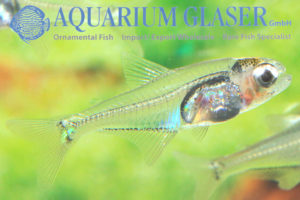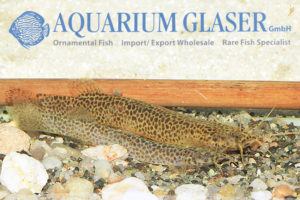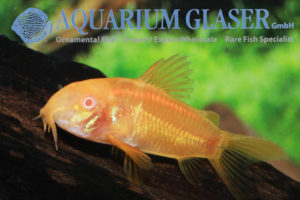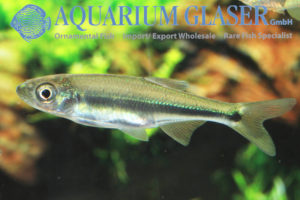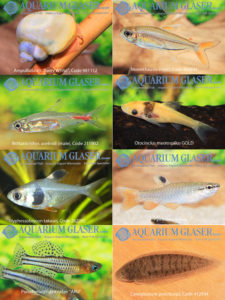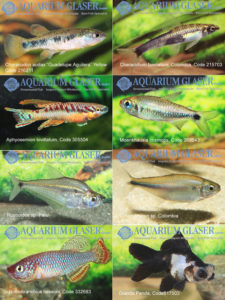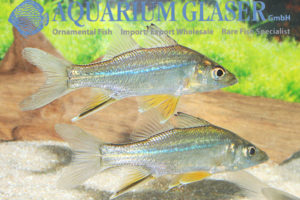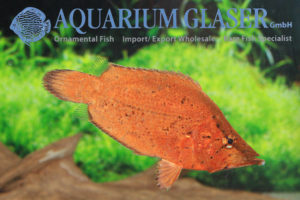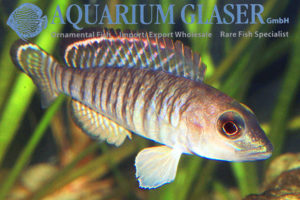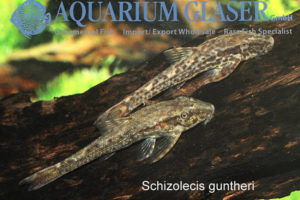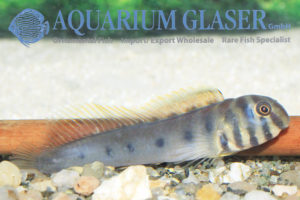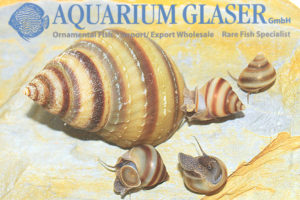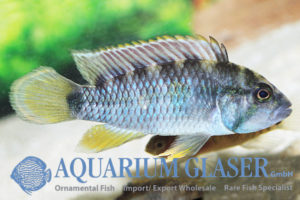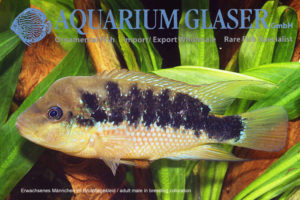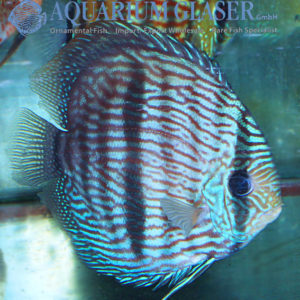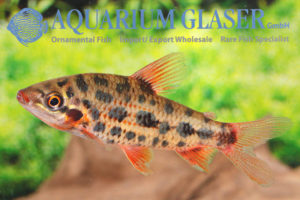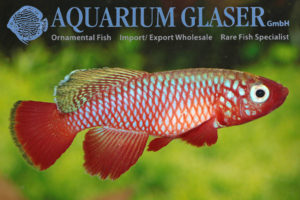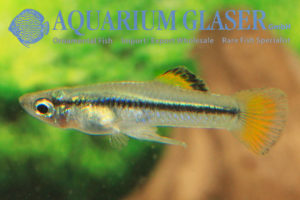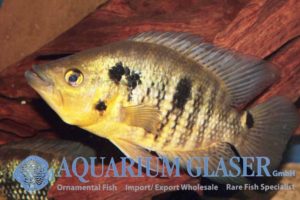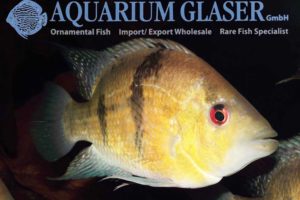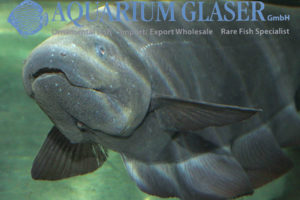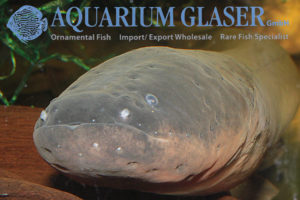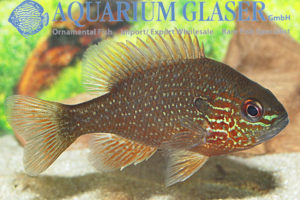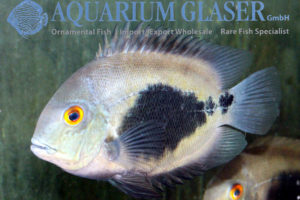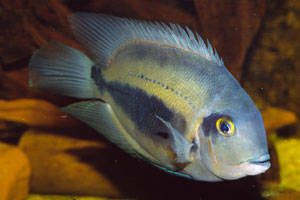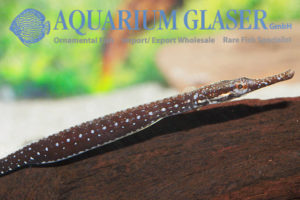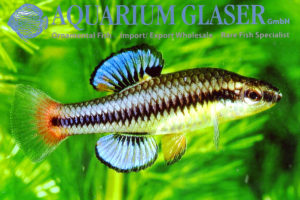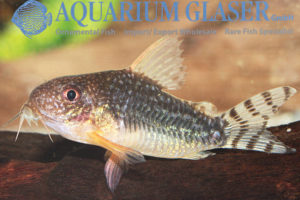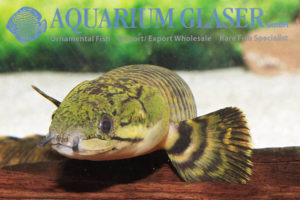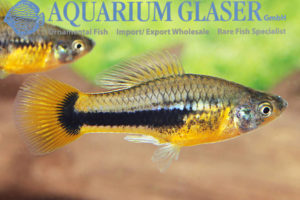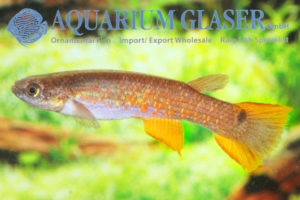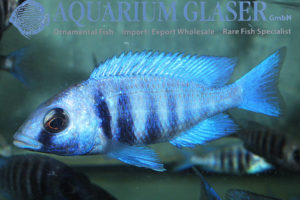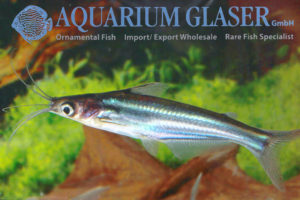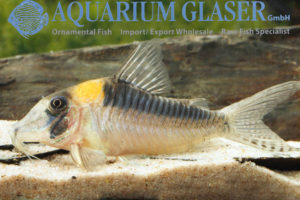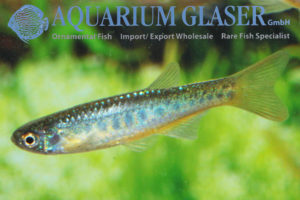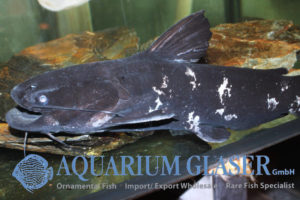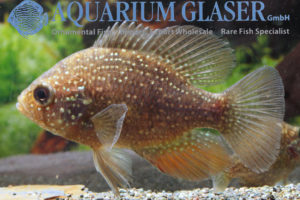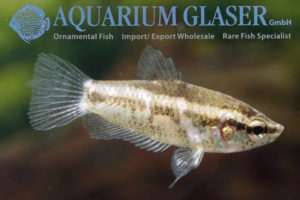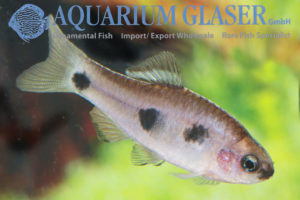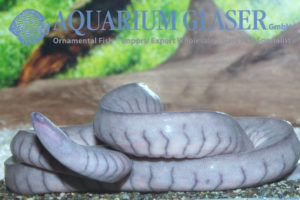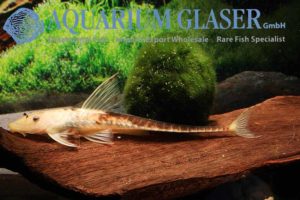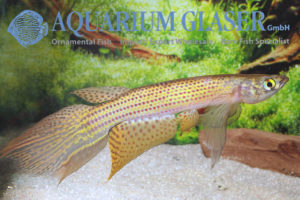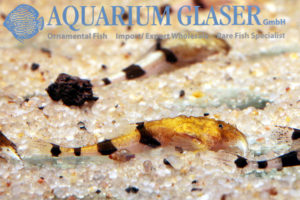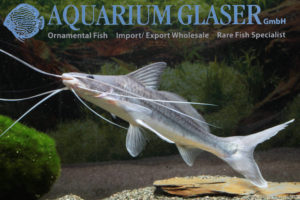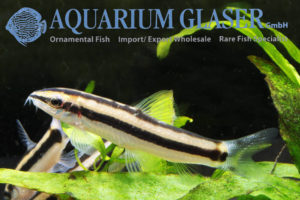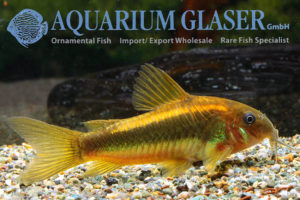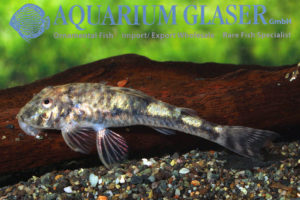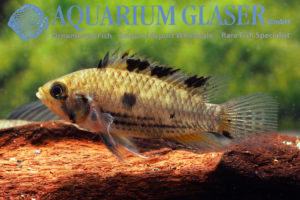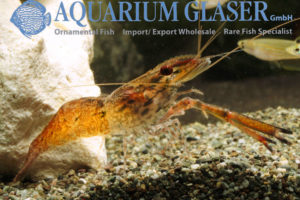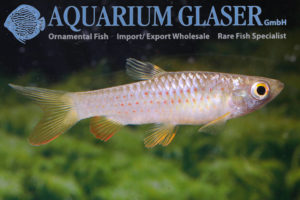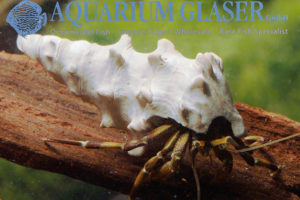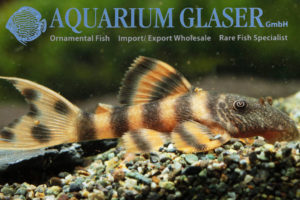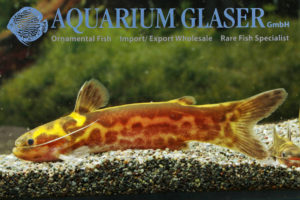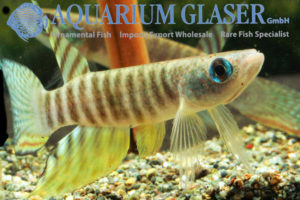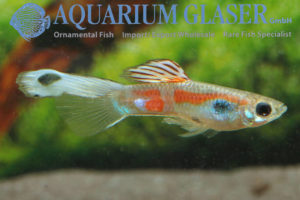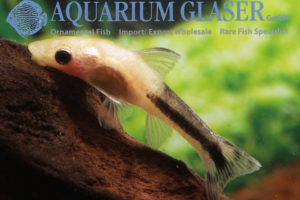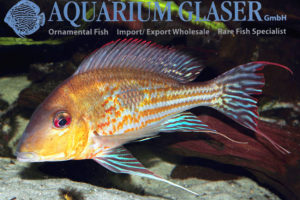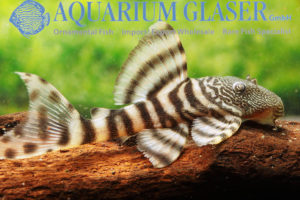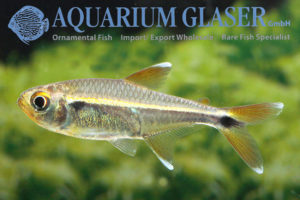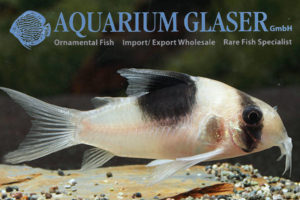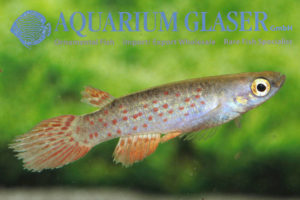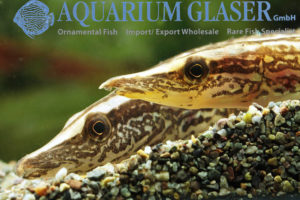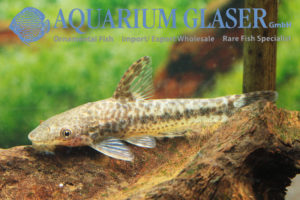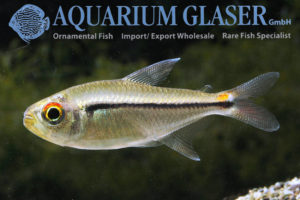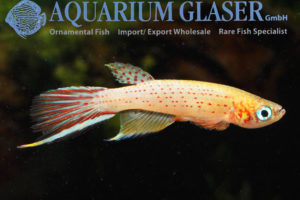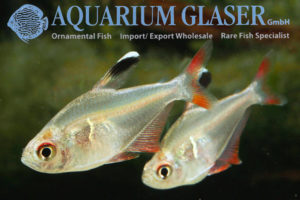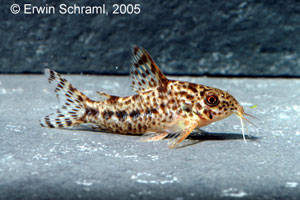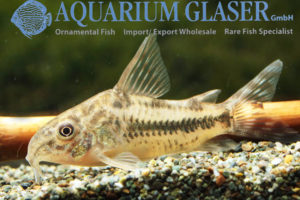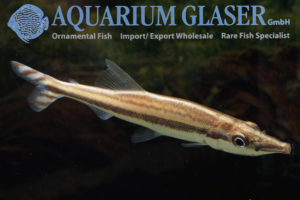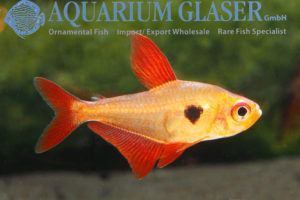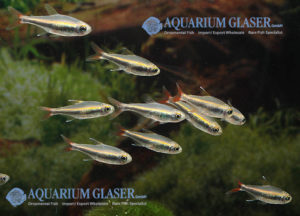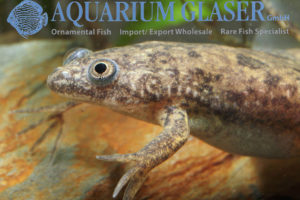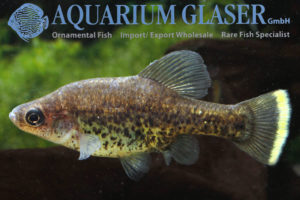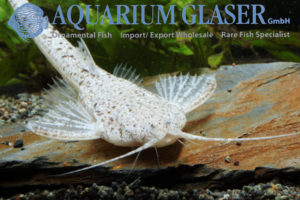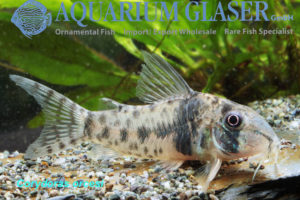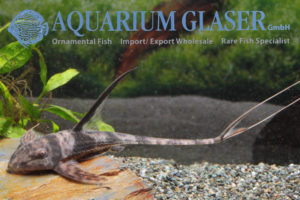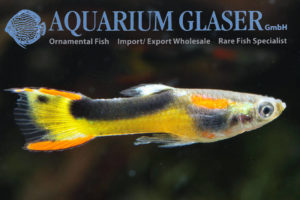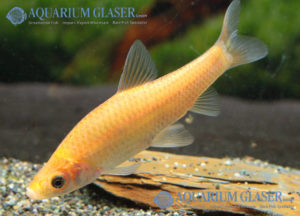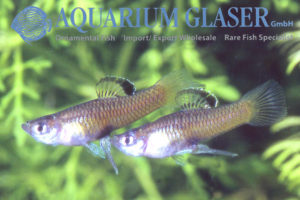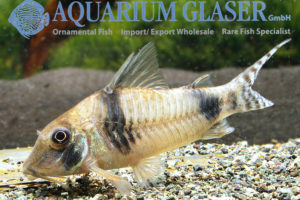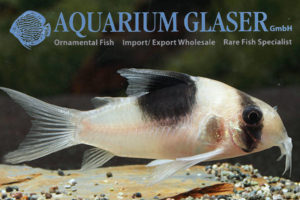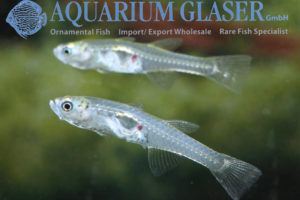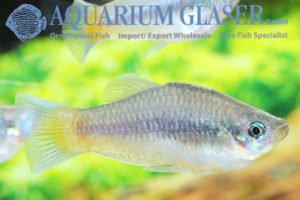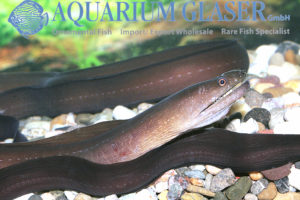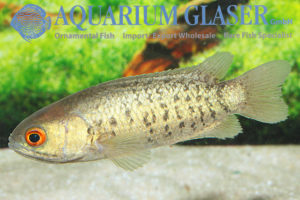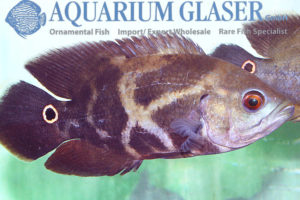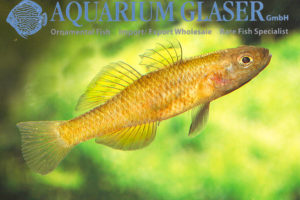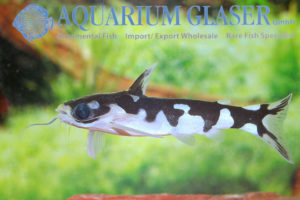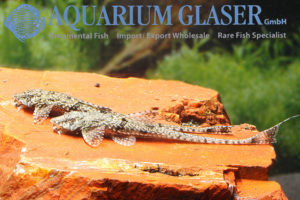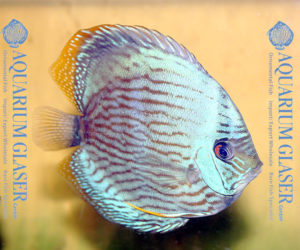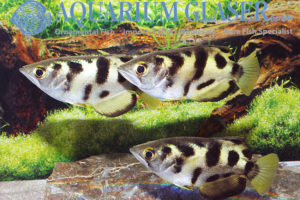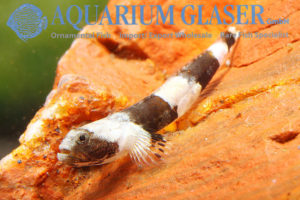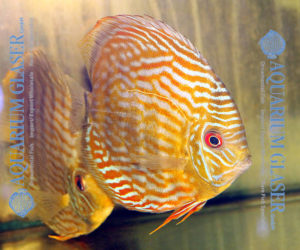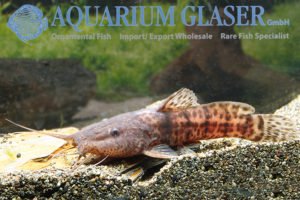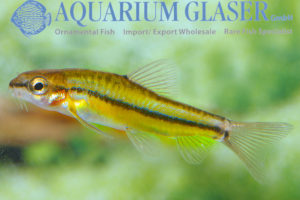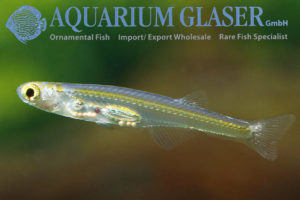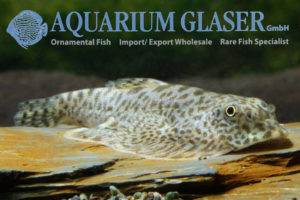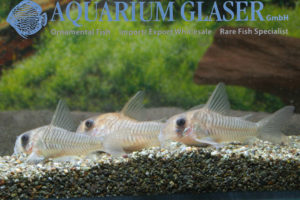Recently described: Cyanogaster cf. noctivaga We were able to import a new species of dwarf tetra in january 2011 from Peru. The tiny fish were only 1-2 cm long and we were neither able to assign them to an existing genus nor to an existing species. Thus we gave them the provisional name Characidae gen. […]
Fish Archive (3044)
-
-
Ituglanis cf. metae
Code number: 264302 photos: Frank Schäfer
-
Corydoras sp. Neon Goldstripe Albino CW10
Code number: 221092 Photos: Frank Schäfer
-
Candidia barbata
Code number: 408003 Photo: Frank Schäfer
-
New in stock calendar week 1, 2011
Dear customers, our weekly importatios regularly content species and varieties we never or only very occassionally had in stock. Thus they are – at least for us – new. Sadly it is for different reasons not possible to portray all of them in detail. However, we want to show you at least some of the […]
-
New in stock calendar week 52, 2010
Dear customers, our weekly importatios regularly content species and varieties we never or only very occassionally had in stock. Thus they are – at least for us – new. Sadly it is for different reasons not possible to portray all of them in detail. However, we want to show you at least some of the […]
-
Centropomus unionensis
The snooks (Centropomus) are distributed in the New World; currently 12 species are recognized. Persons that are reminiscent of giant perches (Lates) by looking at snooks are not wrong: until quite recently the snooks and the giant perches were united in a single family, Centropomidae. We were now able to import a pretty species of […]
-
Monocirrhus polyacanthus
The Leaffish, Monocirrhus polyacanthus, belongs to the most astonishing species of freshwater fish at all. The species – the genus Monocirrhus is monotypical – is spread all over the Amazon basin. It is found in Bolivia, Brazil, Colombia, Peru, and Venezuela. Our imports usually come from Peru, so the current one does. The Leaffish belongs […]
-
Lamprologus signatus
This beautiful cichlid from Lake Tanganyika belongs to the dwarf cichlids. Males become around 5.5 cm, females around 3.5 cm long. At the first glimpse one would think that these tiny fish are “snail brooders”, e.g. that the females would spawn only in empty snail shells. However, this is not true. In their natural habitat […]
-
Oryzias cf. woworae
The ricefishes (Oryzias) are well known in the aquarium hobby. Currently 26 species are recognized scientifically. The latest described species is also the most beautiful one: Oryzias woworae was named only in 2010! Immediately after its description it was imported for the aquarium hobby and caused a sensation. We are glad to be able to […]
-
Schizolecis guntheri and LG4
The coastal rainforests of southeastern Brazil are the home of a good number of unusual aquarium fish. One of the most popular and most attractive species from that region is for sure Scleromystax barbatus, the Bearded cory (formerly known as Corydoras b.). Sadly the natural habitats in that region are much affected by the growing […]
-
Omobranchus zebra
Omobranchus belongs to the Blenniidae family, most of which live in marine environments. Due to their funny behaviour and the generally easy keeping the blennies are favorite fish of the marine hobbyists. There are only very few species that settle permanently in fresh or brackish water. One of the latter is the pretty Omobranchus zebra, […]
-
Taia naticoides
This nice, live bearing snail could be imported again from Inle lake in Burma. It is a close relative to the European species of Viviparus (river snails). Like these they feed on soft particles like mouldered food tablets, detritus etc. They do not fit for fights against algae. On the other hand they also leave […]
-
Apistogramma panduro var. “Marsel”
We were able to import this new dwarf cichlid from Peru now. The fish is without any doubt a close relative of the species Apistogramma nijsseni, A. panduro and the still undescribed A. sp. “Inka II”. In contrast to these species the seam around the caudal fin in males is yellow instaed of red-orange. The […]
-
Cichlasoma istlanum
The large cichlids from Central America are a bit out of fashion currently. That is a sad thing, for hardly any other fish combines in such a perfect matter brillant coloration, personality and interesting behaviour. Of course these fish need large tanks and an equipment that fits their needs, but if these things are given […]
-
Discus champions on a visit
Once more our Japanese friend Mr Akira Ishinabe has placed his discus he displayed in the current discus championship in Duisburg in our facility to give them an opportuntity to rest a bit after the stress of the exhibition before they turn back home to Japan. His Green Wild was able to get the first […]
-
Leporinus sp. “Strawberry”
Currently we were able to import the most beautiful species of Leporinus we have ever seen from Brazil. As the determination of juvenile Leporinus is almost impossible in many cases we decided to adopt the exporter ´s name given for the fish on his stocklist. Without any doubt, however, the new fish belongs to a […]
-
Nothobranchius cardinalis
We have this beautiful nothobranch currently as bred specimens in stock. Nothobranchs are in general extremely beautiful fish, but this species is even more beautiful due to its deep red colours and the minuite size. The species is already known in the hobby for quite a long time. In Aqualog “Killifishes of the World – […]
-
Flexipenis vittatus
Once more we are able to offer a beautiful dwarf livebearer that proofed to be a bit problematical in respect of breeding – not keeping! – in a long time sight under traditional aquarium conditions. However, under the open skies of Southeast Asia they breed pretty well. Flexipenis vittatus is also often placed in Gambusia. […]
-
Caquetaia kraussii
In the wild, Caquataia kraussii is something like a million fish. There is literally no waterbody, may it be pond, lake, or river in the Llanos of Venezuela without this cichlid. So the cichlid enthusiast is a bit left alone with the question why it takes so long if one searches for this fish in […]
-
Caquetaia myersi
Caquetaia myersi belongs definetly to the real rarities in the aquaria of the world. The main reason for this is the fact that it occurs in the wild far from the usual collecting sites in Colombia. What makes fishing in those areas even more difficult is the presence of guerilla which has quite different interests […]
-
Parapteronotus bonapartii
There is a lot of movement in the South American Knifefishes. Science has put an eye on these fascinating, electrical fishes and so a flood of new species descriptions and revisions has been published quite recently. Most genera and species are only weakly electric and use the electric pulses for orientation and communication. However, the […]
-
Newly in: Electric eels
Wonderful Electric eels (Electrophorus electricus) from Peru reached us lately. The animals are 40-50 cm long. The three of them are astonishingly peaceful among each other and feed readily. The fish have nice pale spots on the flanks, which are typical for specimens from Peru and which make the fish even more attractive. For our […]
-
Lepomis megalotis
Sunfishes belong to the most colourful species of coldwater fish. The most widespread species in the hobby is Lepomis gibbosus, but the genus comprises not less than 12 species. Lepomis megalotis is native from NE-Mexico to the Great Lakes in the US and is additionally introduced in many countries. Up to six subspecies have been […]
-
Uaru amphiacanthoides
Extremely beautiful, fully grown specimens of this amazonian species of cichlid reached us now from Brazil. Uaru are peaceful fishes that can be best compared with discus regarding demands on water quality and temperature. However, Uaru are more or less specialized herbivorous fishes. For our customers: the fish have code 688517 on our stocklist. Please […]
-
Uaru amphiacanthoides
This large cichlid, which can grow up to 30 cm in length, has a wide distribution throughout South America. Despite its modest colouration and considerable size this species is well known in the fish tanks of the aquarium hobbyist, mainly because of the interesting behaviour and the lack of aggressiveness against fellow tank mates. Especially […]
-
Hippichthys penicillus
Currently we were able to import a new species of freshwater pipefish from India: Hippichthys penicillus. Basically speaking, there are two types of pipefish. First, the ones that swim free in the water column, imitating plant material (sticks etc.). Twice the ones that are bottom-dwellers and crawl like snakes between plants, stones, roots etc.. The […]
-
Lucania goodei
Once more we were able to stock another real gem among the aquarium fish: Lucania goodei. The Bluefin killifish originates from Florida and reaches a length of about 5 cm. Our specimens are German bred. In contrast to most other species of killifish this is a schooling species. To observe the harmless comment fights of […]
-
Corydoras gossei
Currently we have beautiful German bred specimens of Corydoras gossei in stock. This is a very lively species of Corydoras. It originates from the Rio Mamoré in Brazil. Wild collected specimens are hardly ever available. Corydoras gossei is a close relative of C. sterbai. However, due to the dark basic coloration in C. gossei the […]
-
Polypterus mokelembembe
Bichirs are so-called living fossils. 60 million years old fossilizations are known which can be assigned to recent species! There are 16 recent species known so far, all of them originating from Africa. The latest discovered species is also the smallest one: Polypterus mokelembembe was described in 2006. Formely the species was confused with P. […]
-
Xiphophorus variatus
The Variable platyfish (Xiphophorus variatus) is represented in millions of home aquaria by uncountered cultivated forms. However, their wild ancestors – and there are a lot of different populations – are almost unknown even to the most experienced aquarists. As the specific name already suggests: each local population looks different. The place of origin of […]
-
Rivulus rectocaudatus
The killifishes of the genus Rivulus represent the most species-rich genus of New World Killis. We received recently beautiful R. rectocaudatus from Peru, which are unique due to their amazing orange anal and caudal fins, as well as due to their orange scales along the body. Rivulus are not annual fish at all, but live […]
-
Placidochromis sp. “Phenochilus Tanzania”
The generic placement of the Malawian cichlids formerly lumped in the genus Haplochromis depend on their melanin pattern, eg the black markings in the basic coloration. Sadly the melanin pattern is not recognisable in the only existing type specimen of Haplochromis phenochilus, which was described in 1935; thus its correct generic placement remains unknown until […]
-
Pseudeutropius – the mini shark cats
The shark cats belonging to the genera Pangasius and Pangasianodon are very popular. The reason is their interesting swimming behaviour which reminds one in sharks. However, these fish have one big disadvantage: they grow to a very large size. Even the smallest of them, the common Siamese shark Pangasianodon hypophthalmus, becomes at least 30 – […]
-
Corydoras serratus
The saddle-nosed Corydoras serratus from the upper Rio Negro in Brazil belongs to the most wanted species of Corydoras. Due to the fact that the saddle-nosed species of Corydoras are in general no schooling fish it is not possible to collect larger numbers of them in an economically senseful way. This and the fact that […]
-
Danio aesculapii
Back in 2005 we were able to import this pretty species from Burma for the first time. This appeared under the provisional trade name Danio sp. “Pantherinus” (see http://www.aquariumglaser.de/en/danio-sp-pantherinus-_de_699.html). In 2009 the species was formally described as Danio aesculapii. It was named after the ancient Greek god of medicine, whose regalia were a stick with […]
-
Trachycorystes sp. WHITE SPOTS
The genus Trachycorystes currently comprises three described species. In the aquarium hobby so far only T. trachycorystes appeared. For this up to 45 cm long species, please see http://www.aquariumglaser.de/en/news/Trachycorystes_trachycorystes_en/ Recently we received a 25-30 cm long specimen from Peru with an unique coloration: white, irregular spots on both sides of the body! It is unknown […]
-
Enneacanthus gloriosus
The Bluespotted Sunfish (Enneacanthus gloriosus) is a coldwater fish and a real oldtimer among aquarium fish. Aquarists used to name the up to 7.5 cm long fish “working class discus”, due to its brillant colours and the nice behaviour. However, it was never as expensive as the discus. Bluespotted Sunfish occur in nature along the […]
-
Parasphaerichtys lineatus
Once more we have the smallest anabatoid fish of the world in stock: Parasphaerichthys ocellatus, the mini chocolate gorami. This tiny species hardly reaches 2 cm in length. In contrast to all other chocolate gouramis this is a bubblenester builder (all others are mouthbrooders) and should be kept and bred in harder, slightly alcalic water […]
-
Barbus candens
Three very similar species of dwarfish barbs occur in the central Congo basin. All of them become only 3-4 cm long. Additional forms are already known, but not researched scientifically yet. The three described species are B. candens, B. hulstaerti, and B. papilio. They live in shadowy brooks that have a acidic (pH 5.0 – […]
-
Potamotyphlus kaupii
Most people interested in natural history know two orders within the class Amphibia, namely the Anura (frogs, toads etc.) and the Caudata (news, salamanders etc.). Much less people know that there is a third order, the Gymnophiona (caecilians), although this order has more than 180 species. However, most of them are nocturnal and live burrowed […]
-
Hemiloricaria sp. Golden (Lutino)
This wild collected specimen from Peru has a very unique colour aberration. Usually such specimens cannot survive in the wild, but this fish is a healthy, adult animal. For our customers: the fish has code 257924 on our stocklist. Please note that we exclusively supply the wholesale trade. Lexicon: Hemiloricaria: ancient Greek, means “half loricaria”; […]
-
Moema cf. ortegai
We were able to import astonishing large Moema cf. ortegai from Peru. The females are around 8 cm, the males around 12 cm long. This places them among the largest species of killifish known so far. The extremely large pectoral fins of the males are very impressive. However, the whole finneage of the males is […]
-
Ernstichthys megistus
For the first time we were able to import a very astonishing species of catfish, which was known until 1985 from 3 specimens only. At the first glimpse the small animals – they are hardly 2 cm long – remind one on the Asian catfishes of the genus Akysis. Actually they are relatives of the […]
-
Pinirampus sp. Paraguay
The catfish family Pimelodidae is restricted to South America. It is a quite diverse family. Although only about 90 species are known they could hardly be more contrasting. The smallest species (a still undescribed one from the Amazon river) becomes only 2.5 cm long, the largest (Brachyplatystoma filamentosum) becomes 2 metres long. Most species, however, […]
-
Yasuhikotakia nigrolineata
This pretty loach is distributed in Laos, Thailand and parts of China. Obviously it is a close relative of the dwarf chain loach, Y. sidthimunki, and the behaviour of Y. nigrolineata is absolutely the same. However, there are two distinguishing features – besides the coloration: first, Y. nigrolineata become a bit larger, about 8 cm […]
-
Corydoras sp. Neon Goldstripe, CW 10
There are many attractive and desirable species of Corydoras, but one would hardly describe many of the about 300 species known so far as colourful. One of the very few really colourful Corydoras is the scientifically still undescribed species Corydoras sp. Neon Goldstripe, that we were able to import again in larger numbers now from […]
-
Parotocinclus jumbo, LDA 25, Pitbull Pleco
The import season for this charming algae killer has started. Parotocinclus jumbo is both one of the largest species of the genus (maximum size is reported to be around 6-7 cm!) and one of the prettiest. Astonishingly there is so far no report in the aquarium literature on the very obvious sexual dichromatism found in […]
-
Apistogramma cactuoides WILD
Some species of fish are very popular in the aquarium hobby. Many of them are kept only as sports or breeding forms that do not exist in the wild and most aquarists are completely unaware how the wild form looks like. One of these species is the very popular dwarf cichlid Apistogramma cacatuoides. The species […]
-
Macrobrachium brasiliense
Most freshwater shrimps that are established in the hobby originate from Asia and Afrika. Not even one species from South America has become a permanent aquarium inhabitant. There are several reasons for that, but the most important one is the fact that in most species from South America the larvae develop in marine environments. This […]
-
Copeina cf. osgoodi
At least in Germany members of the genus Copeina are pretty well known, which is reflected by the fact that an accepted common name exists: Forellensalmler, which means “trout tetra”. However, this knowledge is rather outdated and nowadays the fish can be regarded as real rarities in the hobby. There are only two accepted species […]
-
Clibanarius africanus with white shells!
The charming hermit crab Clibanarius africanus has become a very popular aquarium inhabitant. It is an euryhalin species, which means that it can survive in both pure fresh and pure marine water. However, it seems that it can live in pure freshwater only for a few months, so it is much better to keep it […]
-
Panaqolus sp. PUCALLPA
Once more we were able to import another quite cute suckermouth catfish from Peru – from Pucallpa to be more precise. Again, this species belongs to the closer Panaqolus changae relationship (LDA 26, L206, L226), as it does the “New Zebra Pleco” we introduced to you last week (http://www.aquariumglaser.de/en/news/Panaqolus_sp_NEW_ZEBRA_JUTAI_en/). Especially the young ones are colored […]
-
Tatia dunni
Once more we were able to be the first who imported this pretty driftwood cat. The identification of Tatia species is not that easy. Although there is a very recent revision of the genus available, the species concept used there reflects only few aspects of coloration. So currently fish of very different coloration are lumped […]
-
Aphyolebias peruensis
This species from Peru represents one of the most beautiful species of killifish. It was known in the hobby for quite a long time under the name of Pterolebias peruensis. They are typical seasonal fishes. In the aquarium, they might become up to 1.5 years old, but in the wild they will never reach such […]
-
Guppy Venezuela Top Sword
Since quite a long time we receive wild guppy types from one of our breeders. These wild types are much sought for, due to their brilliant colours, their lively temper and their perfect adaptability to almost any aquarium conditions. Under the name of guppy “Venezuela” recently wonderful fish in show size with top sword reached […]
-
Otocinclus vestitus PARAGUAY
The season for this popular Otocinclus has started now. Otocinclus vestitus has a very large distribution. It is found in Peru, Bolivia, and Paraguay. The species can be easily identified by the typical pattern in the caudal fin. Among the O. vestitus we received this week from Paraguay was one very unusual xanthoristic specimen. It […]
-
Geophagus megasema
There is almost no chance that commercial importations of wild collected Geophagus megasema will ever appear. So it is very welcome that travelling aquarium enthusiast collect such species in areas that are ignored by professional fish collectors and bring them home alive, which makes it possible to develope a captive bred stock. Geophagus megasema was […]
-
Panaqolus sp. NEW ZEBRA JUTAI
This extremely attractive new suckermouth cat was sent to us from Peru with the name of a collecting site “Jutai”. Currently the fish are around 4-6 cm long. There is no doubt that they belong to the Panaqolus changae group (LDA 26, L206, L226). A very astonishing matter in these fish is the fact that […]
-
Hemigrammus sp. Boqueron
Currently we received from Peru a new species of Hemigrammus, which does not fit the description of any species known so far. Thus we decided to adopt the name on the import list, eg. “Boqueron”. The pretty fish looks like a cross of the glowlight tetra (Hemigrammus erythrozonus) and the silvertip tetra (Hasemania nana). Due […]
-
Corydoras sp. “New Panda” CW51
Corydoras sp. “New Panda” from Colombia is so far the most spectacular new importation of the year. Hans-Georg Evers, expert for Corydoras, guesses that the species may be found in the Rio Vaupes system, but still no assured information on that topic is available. It is very conspicious that the spot below the dorsal fin […]
-
Rivulus ornatus
This tiny jewel among the fishes, which we were able to import from Peru recently, causes some confusion among taxonomists. It is possible that this fish represents a still undescribed species and will be named seperatly in the future. May this be as it wants, we are glad to have this pretty animal in stock […]
-
Mastacembelus caudiocellatus
Recently we were able to import this pretty spiny eel from Burma for the first time. It is a rather small (around 20 cm) species with a very contrasting pattern. The species lives endemically in the Lake Inle region in Burma. Lake Inle has medium hard water with a slightly alcalic pH. From Lake Inle […]
-
Otocinclus mimulus
For the first time ever we are now able to offer a very rare Otocinclus species, namely O. mimulus. Besides all the well known good characteristics that it shares with other members of the genus – small size, peacefulness, cleaning of plant leaves, day activity – this species also has to offer a very special […]
-
Hyphessobrycon eschwartzae (= Hyphessobrycon cf. agulha JURUA / PERU)
For the first time ever we were able now to import this beautiful tetra from Peru. Scientifically H. agulha is known for quite a long time, but it has never become an aquarium fish so far. In Jaques Géry´s classical work on Characoids of the World even a complete group of Hyphessobrycon is named after […]
-
Aphyolebias schleseri
A very unusual killi is Aphyolebias schleseri, which can be recognized by its unique sword. The species has been described only in 2003 and initially we thought it to be a new species of Micromoema. However, some members of the German killifish association (DKG) helped to trace the correct name. Once more: thank you guys! […]
-
Hyphessobrycon cf. pando PERU
Recently we received beautiful Rosy tetras under the name of “Hyphessobrycon robertsi” from Peru. However, the fish is not identical with the well known “robertsi” (the species has not been described formally by a scientist yet, but it is unknown whether is has been made available “by chance” in the past 60 years of its […]
-
Corydoras diphyes
This Corydoras is available irregularly in Germany and has been recently described by Axenrot and Kullander (2003). C.dyphyes originates from the tributary of the Rio Monday, a river flowing into the Rio Parana in Paraguay. This species was described, for a long time, as Corydoras flaveolus which comes however from the Brazilian state of Sao […]
-
Corydoras diphyes
It has been quite a long time since we were able to import this pretty species from Paraguay, but now we managed it! Please click here for further information: http://www.aquariumglaser.de/en/fish-archive/corydoras-en/Corydoras_diphyes_en/ Text & photo: Frank Schäfer
-
Ichthyborus ornatus
The odd subfamily of African tetra called Ichthyborinae is restricted to Africa. Many species are specialized fin eaters that feed almost exclusively on fins of other fish. Their teeth work like a scissor and are able to cut out pieces of fin from other fish without any problems. Almost all of these tetras – there […]
-
Megalamphodus
Honestly speaking, the trade name for this cute fish is completely wrong: first of all, the genus name Megalamphodus is regarded nowadays as a synonym to Hyphessobrycon and twice the species in question is an undescribed one and not identical with the red phantom tetra, H. sweglesi. However, even undescribed fish have to be named […]
-
Hyphessobrycon loretoensis
Some species of ornamental fish live in a kind of shadowy existence. Basically speaking they are always available, beautiful and ideal aquarium fish, but it seems that nobody keeps them actually. One of those species is Hyphessobrycon loretoensis. The tiny tetra (maximum length around 3.5 cm) has been imported as an ornamental fish in 1938, […]
-
Xenopus muelleri
Clawed frogs or platannas (Xenopus) are popular aquarium inhabitants. They are totally aquatic animals and leave the water only for curiosity or when the water body dries out. Nevertheless the tank has to be absolutely safely covered, for a trip in the dry living room can cause the death of the animal. Most often Xenopus […]
-
Chapalichthys pardalis
The Polkadot Goodeid, Chapalichthys pardalis, reaches a maximum length of 6.5 cm (males) and 7 cm (females). Its natural habitat are the waters of the pacific slope of Mexico, Michoacan province, Tocumbo district. In contrast to many other goodeids this pretty, livebearing species seems not to be endangered in the wild. In the aquarium, however, […]
-
Ancistrus sp. 2-color
Ancistrus sp. 2-color The origin of our “common” aquarium-Ancistrus is not recorded. Since the very first importation to Europe – around the year 1911 – in all probability several similar species have been crossed accidentally. In the wild, these species obviously have no contact to each other. So there was no necessity during their evolution […]
-
Pseudobunocephalus sp. White Peru
The genus Pseudobunocephalus has been erected quite recently (2008). It is distinguished from the other banjo cat genera by externally invisible characters of the teeth and bone structures. As aquarists are more interested in fish than in technical definitions of genera it may be mentioned that nevertheless there are some external features that allow to […]
-
Corydoras orcesi
This beautifully marked species appeared only very occasionally in the aquarium hobby. The fish has been described from the Rio Tigre system in Ecuador. Initially it was described as a subspecies of the similar Corydoras pastazensis. However, so far no intergrades have been found and this makes it very likely that both are seperate species. […]
-
Lamontichthys llanero
This beautiful catfish comes from Venezuela. Lamontichthys are very sensitive and need extremely clean water. Another problem is that they often refuse food. This is obviously a problem due to the shyness of the fish. Even relatively small disturbances let them stop feeding for hours. This is the reason why Lamontichthys are kept best in […]
-
Brandnew: Guppy Endler Yellow Half Tuxedo
This week we were able to import a new sport of the Endler Guppy for the first time. Its bright contrasting yellow and black coloration will for sure excite the guppy enthusiasts. Regarding body shape and behaviour this new sport is a typical Endler Guppy (Poecilia wingei). This means it is a rather small fish […]
-
Pseudorasbora parva GOLD
For the first time we have a golden sport (the scientific word for that phenomenon is xanthoristic) of the Stone moroko (Pseudorasbora parva) in stock. Like all our garden pond fish the specimens are bred ones. The Stone moroko originates from Asia, where it occurs naturally in the northeastern parts (former USSR, China, Japan, etc.). […]
-
Phallichthys tico
For the first time ever we are able to offer this top-rarity among the livebearers. The charming fish – males reach a maximum length of about 2.5 cm, females 4.5 cm – are restricted to the upper reaches of the river San Juan in Costa Rica and Nicaragua. No commercial fishing for ornamental fish does […]
-
Corydoras sp. aff. reynoldsi CW12
Repeatedly we were able to import the longnosed Corydoras from Colombia that resembles the shortnosed C. reynoldsi. For the latter please check http://www.aquariumglaser.de/en/corydoras-reynoldsi–corydoras-tukano_en_1074.html. The longnosed species represents a species undescribed by science so far. Like all longnosed Corydoras this fish is somewhat variable regarding coloration. In contrast to the shortnosed species, longnosed Corydoras live more […]
-
Corydoras sp. NEW PANDA
Last week we received for the first time ever this beautiful new Cory. Its fantastic black-and-white-coloration will make it without any doubts to one of the favorite species for Corydoras enthusiasts. Specialized aquarists already know the fish under the code CW51. More about this new entry here: http://www.aquariumglaser.de/en/fish-archive/corydoras-en/Corydoras_sp_New_Panda_CW51_en/ Text & photos: Frank Schäfer
-
Gobiopterus chuno
Glass perches and glass catfish are well known and common aquarium fish. But do you know glass gobies, too? The members of the genus Gobiopterus (there are so far 9 known species) are tiny freshwater gobies. They reach only 2-3 cm length and are so transparent that the observer can see how a food item […]
-
Priapella chamulae
We obtained a good number of this quite rare livebearer from a German breeder. Priapella are specialized fish. The best known species in the hobby is for sure Priapella intermedia. Like this species, P. chamulae has brillant blue eyes. Priapella are schooling fish that live near the surface in brooks. These conditions, eg keeping in […]
-
Strophidon sathete
For the first time now we have some specimens of the largest moray eel of the world in stock: Strophidon sathete. This species originates from brackish water regions. They inhabit the very same habitats (lower reaches of rivers) as the common freshwater moray, Gymnothorax tile. Both can be kept like scats or monos: they are […]
-
Anabas cf. macrocephalus
The Climbing Perches (Anabas) are no popular aquarium fish at all. Scientists also do not work on them and so the systematics of the genus are quite unclear. Members of the genus can be found all over the tropical and subtropical areas of South and Southeast Asia. However, it often remains unclear wether the fish […]
-
Astronotus ocellatus wild, Colombia
The Oscar, Astronotus ocellatus, belongs to the most popular species among the large cichlids. It was imported to Europe in 1929 for the first time. In Asia, many different sports have been bred since. However, the wild ancestors of the Oscar remain somewhat mysterious and little understood. Until recently, only one or two species were […]
-
Mugilogobius rexi
This small, yellow goby is a free swimming species, in contrast to most of the other gobies. Maximum length is about 4-5 cm. Territorial males become bright yellow and also develope larger fins with dark bands. Females are much paler in coloration and have translucent fins. The species is restrictet to Sulawesi and even on […]
-
Centromochlus sp. Ninja (= C. orca)
A small sensation reached us recently from Brazil. Already when the small (4-6 cm long) catfish were unpacked their brillant black-and-white-pattern was a real eyecatcher. The fish definetely belong to the genus Centromochlus, which currently comprises 11 species in South America. These fish are close relatives of the better known genus Tatia and belong (like […]
-
Hemiloricaria beni
Now we can offer the smallest known species of whiptail catfish: Hemiloricaria beni. It hardly becomes longer than 8 cm. As this species occurs only in Bolivia and no commercal exportations from Bolivia appear, we offer only bred ones. Initially Swiss aquarists collected this species on a private collecting trip in 1997. Since then a […]
-
Discus Heckel / Jatapu
The series of astonishing wild collected discus we are able to offer right now does not break off. Besides the wonderful Royal Blue which we introduced to you last week, we also have excellent Heckel blue-head said to come the Jatapu river. This branch of the Amazon river has an unique mix of fauna found […]
-
Toxotes sp. New!
A new species of Archerfish! Recently we received a shipment containing archerfishes (Toxotes) from Thailand. Most of the shipment were T. jaculatrix (see http://www.aquariumglaser.de/en/toxotes-jaculatrix_en_1076.html) and some T. chatareus (see http://www.aquariumglaser.de/en/toxotes-chatareus_en_1044.html). But a closer look showed also four specimens of an unique colored archerfish, which we have never seen so far and which fits to none […]
-
Schismatogobius ampluvinculus
We received for the first time now this cute goby from Taiwan. Especially when it is in the right mood it looks extremely pretty due to its contrasting black-and-white coloration. One of the generic characteristics of Schismatogobius is the fact that they have an individual coloration: there are not even two specimens with the exact […]
-
Discus Royal Blue Novo Ariguana
Yesterday (2.2.) we received breathtaking beautiful large wild collected discus called Discus Royal Blue Novo Ariguana. All insiders will understand that the fish do not show all of their beauty today, but even what they show is amazing! Text & photo: Frank Schäfer
-
Parauchenoglanis punctatus
Parauchenoglanis punctatus: Among the imports from central Africa this beautiful catfish is a real rarity. It is known so far only from the central Congo basin. From that region only few fish are imported regulary. The species attains a length of approximately 40 cm. Thus it is a perfect tankmate for show aquaria with larger […]
-
Yunnanilus sp.
The genus Yunnanilus comprises a comparably high number of species: 30 species are currently recognized as valid, but there are for sure much more species. Most known species have a very small distribution area. If you realize that only a very small part of the waters in the area of the genus have ever been […]
-
Danionella dracula
Danionella are extremely small cyprinids, which never grow larger than 2 cm. The species that was discovered first – Danionella translucida – was thought to be the smallest cyprinid in the world, until the even smaller genus Paedocypris was discovered. Currently, four species are recognized by science, three from Burma and one from northern India. […]
-
Sewellia speciosa
Currently we were able to import this nice hillstream loach from Laos for the first time. The species is restricted to the Kong river influence in Laos and Vietnam. Maximum length is around 6 cm. The species has a very interesting sexual dimorphism. Males – which are in general more tiny than females – develope […]
-
Corydoras sp. C40
This pretty cory comes from the Brazilian state of Rondonia. It is not possible to distinguish the fish from Corydoras griseus externally. However, Corydoras griseus comes from Guyana and between the collecting sites of both species are serveral thoundands of kilometers. So it was decided to wait until a scientist has researched the identity of […]
- « Previous Page
- 1
- …
- 24
- 25
- 26
- 27
- 28
- …
- 31
- Next Page »





